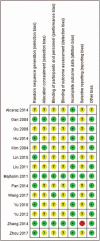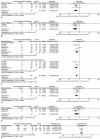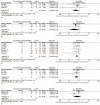Non-needle acupoint stimulation for prevention of nausea and vomiting after breast surgery: A meta-analysis
- PMID: 30855464
- PMCID: PMC6417514
- DOI: 10.1097/MD.0000000000014713
Non-needle acupoint stimulation for prevention of nausea and vomiting after breast surgery: A meta-analysis
Abstract
Background: Breast disease has been a global serious health problem, among women. Surgery is the main treatment for the patients suffering from breast disease. Postoperative nausea and vomiting are still disturbing. Acupoint stimulation, an effective treatment of traditional Chinese medicine, has been used to reduce postoperative nausea and vomiting. Recently, non-needle acupoint stimulation becomes a new intervention. Though several clinical trials have been done, there is still no final conclusion on the efficacy. This Meta-Analysis aims at evaluating the efficacy of non-needle acupoint stimulation for prevention of nausea and vomiting after breast surgery.
Methods: Systematic searches were conducted in PubMed, Embase, Cochrane, and Wanfang Med Online databases for studies. The review period covered from the inception of databases to December 31, 2017. The outcome measures of interest were frequency of nausea, frequency of vomiting, frequency of PONV, verbal rating scale of nausea, and use of rescue antiemetic. Data extraction and risks of bias evaluation were accomplished by 2 independent reviewers using the Cochrane Collaboration Review Manager software (RevMan 5.3.5).
Results: Fourteen randomized controlled trials with a total of 1009 female participants in the non-needle acupoint stimulation group and control group met the inclusion criteria. Although the therapeutically effect on vomiting within postoperative 2 hours was not obvious, non-needle acupoint stimulation still had an important role in reducing nausea and vomiting within postoperative 48 hours. According to Jadad scale, there was moderate quality evidence for the pooled analysis results in this study. In addition, stimulating acupoint by wristband acupressure was more likely to cause adverse reactions.
Conclusion: Non-needle acupoint stimulation can be used for female patients undergoing breast surgery to reduce postoperative nausea and vomiting. Into consideration, we recommend transcutaneous acupoint electrical stimulation on PC6 from 30 minutes before induction of anesthesia to the end of surgery for application. This non-pharmaceutical approach may be promising to promote the recovery of patients after breast surgery.
Conflict of interest statement
The authors have no conflicts of interest to disclose.
Figures






Similar articles
-
Transcutaneous electrical acupoint stimulation versus dexamethasone for prophylaxis of postoperative nausea and vomiting in breast surgery: A non-inferiority randomized controlled trial.Surgery. 2023 Oct;174(4):787-793. doi: 10.1016/j.surg.2023.06.014. Epub 2023 Jul 21. Surgery. 2023. PMID: 37482441 Clinical Trial.
-
Acupuncture and PC6 stimulation for the prevention of postoperative nausea and vomiting in patients undergoing elective laparoscopic resection of colorectal cancer: a study protocol for a three-arm randomised pilot trial.BMJ Open. 2017 Jan 4;7(1):e013457. doi: 10.1136/bmjopen-2016-013457. BMJ Open. 2017. PMID: 28052910 Free PMC article. Clinical Trial.
-
Effect of single or multi-period use of transcutaneous acupoint electrical stimulation on postoperative nausea and vomiting in patients undergoing gynecological laparoscopic surgery: a prospective randomized double-blind trial.BMC Complement Med Ther. 2025 Mar 20;25(1):110. doi: 10.1186/s12906-025-04847-5. BMC Complement Med Ther. 2025. PMID: 40114162 Free PMC article. Clinical Trial.
-
Transcutaneous electrical acupoint stimulation for preventing postoperative nausea and vomiting after general anesthesia: A meta-analysis of randomized controlled trials.Int J Surg. 2020 Jan;73:57-64. doi: 10.1016/j.ijsu.2019.10.036. Epub 2019 Nov 6. Int J Surg. 2020. PMID: 31704425 Review.
-
Efficacy and safety of electrical acupoint stimulation for postoperative nausea and vomiting: A systematic review and meta-analysis.PLoS One. 2023 May 31;18(5):e0285943. doi: 10.1371/journal.pone.0285943. eCollection 2023. PLoS One. 2023. PMID: 37256901 Free PMC article.
Cited by
-
The effects of Korean hand acupressure on postoperative pain, nausea, vomiting, and retching after thyroidectomy: A randomized controlled study protocol.J Educ Health Promot. 2024 Sep 28;13:347. doi: 10.4103/jehp.jehp_1812_23. eCollection 2024. J Educ Health Promot. 2024. PMID: 39679040 Free PMC article.
-
Acupoint transplantation versus non-acupoint transplantation using autologous peripheral blood mononuclear cells in treating peripheral arterial disease.Blood Sci. 2024 Jan 15;6(1):e00175. doi: 10.1097/BS9.0000000000000175. eCollection 2024 Jan. Blood Sci. 2024. PMID: 38226019 Free PMC article.
-
Acustimulation combined with pharmacological prophylaxis versus pharmacological prophylaxis alone in postoperative nausea and vomiting (PONV) prophylaxis among patients undergoing laparoscopy abdominal surgery: a research protocol for a randomised controlled trial.BMJ Open. 2024 Sep 23;14(9):e088633. doi: 10.1136/bmjopen-2024-088633. BMJ Open. 2024. PMID: 39313286 Free PMC article.
-
Integrative and complementary practices to control nausea and vomiting in pregnant women: a systematic review.Rev Esc Enferm USP. 2022 Oct 21;56:e20210515. doi: 10.1590/1980-220X-REEUSP-2021-0515en. eCollection 2022. Rev Esc Enferm USP. 2022. PMID: 36300661 Free PMC article.
-
Antiemetic effects of baclofen in a shrew model of postoperative nausea and vomiting: Whole-transcriptome analysis in the nucleus of the solitary tract.CNS Neurosci Ther. 2022 Jun;28(6):922-931. doi: 10.1111/cns.13823. Epub 2022 Mar 3. CNS Neurosci Ther. 2022. PMID: 35238164 Free PMC article.
References
-
- Hartmann LC, Sellers TA, Frost MH, et al. Benign breast disease and the risk of breast cancer. N Engl J Med 2005;353:229–37. - PubMed
-
- Harbeck N, Gnant M. Breast cancer. Lancet 2017;389:1134–50. - PubMed
-
- Candiotti KA, Birnbach DJ, Lubarsky DA, et al. The impact of pharmacogenomics on postoperative nausea and vomiting: do CYP2D6 allele copy number and polymorphisms affect the success or failure of ondansetron prophylaxis? Anesthesiology 2005;102:543–9. - PubMed
-
- Apfel CC, Heidrich FM, Jukar-Rao S, et al. Evidence-based analysis of risk factors for postoperative nausea and vomiting. Br J Anaesth 2012;109:742–53. - PubMed
-
- Enqvist B, Björklund C, Engman M, et al. Preoperative hypnosis reduces postoperative vomiting after surgery of the breasts. A prospective, randomized and blinded study. Acta Anaesthesiol Scand 1997;41:1028–32. - PubMed
Publication types
MeSH terms
LinkOut - more resources
Full Text Sources
Other Literature Sources
Medical
Miscellaneous

